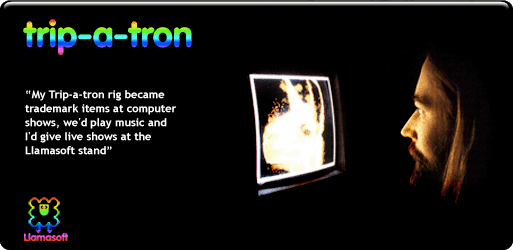Trip-A-Tron

Released: 1987
Trip-A-Tron
This was my most complex lightsynth to date - in fact it was the single most complex program of any kind that I had written at that point, taking fully a year to implement, all in 68000 assembler code. It just kept on growing - it's interesting to note that it took me longer to write the *manual* for Trip-a-Tron than it had taken me to write any of the previous lightsynths themselves }:-).
At the core of TaT was a language called "KML". As its name implies ("Key Macro Language") this began as a simple scripting language intended to allow the user to bind events and sequences to keys on the keyboard. By the time it was finished, KML was an 8-threaded parallel language that you could use to control the entire synthesiser, control remote machines also running TaT using a network based on the MIDI port, render 2D and 3D scenes, capture frames to memory, and play back animations any way you liked. Of course realtime interactive pattern generation was still a fundamental part of it, and you could, if you wished, use TaT as simply a "super Colourspace" without touching any KML coding at all, but to get the most out of it you needed to write some code.
I had just moved to Wales at that time, and a local TV repair man who happened to be a superbly skilled electronics engineer hand-built me a video mixer through which I could mix the outputs of 5 Atari STs - my "performance rig" at that time was quite an imposing array of computers, disk drives, cables and black boxes, usually hooked up to that huge beast of a Barco projector }:-). Using that rig, I did an audiovisual collaboration with a local musician, Adrian Wagner - a cosmic space fantasy called "Merak", which we performed live at the Ars Electronica festival in London, and which was also released on video. It was really pushing TaT to the limits sequencing that entire performance live - I remember that some of the machines had to overlay code and graphics data from disk and would finish loading only a couple of seconds before they were called on for use in the performance - but amazingly it all hung together well.
Once again the projector and my TaT rig became trademark items at computer shows, and we'd play music and I'd give live shows at the Llamasoft stand.
Platforms













